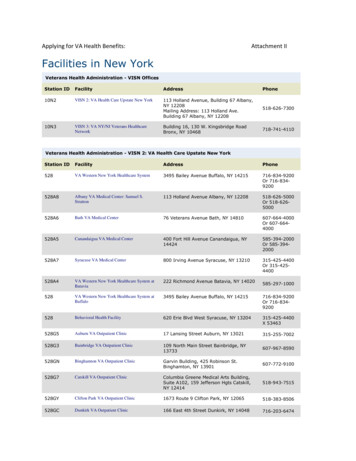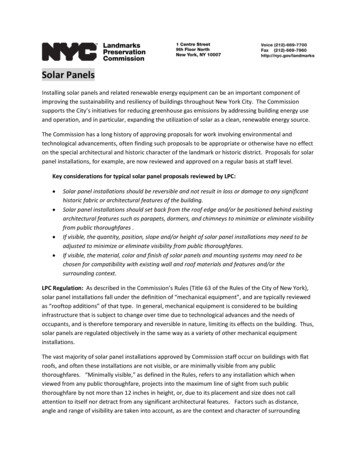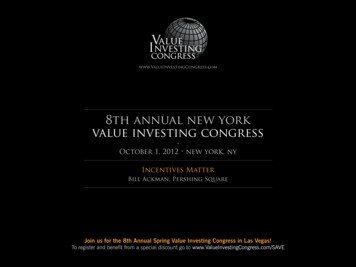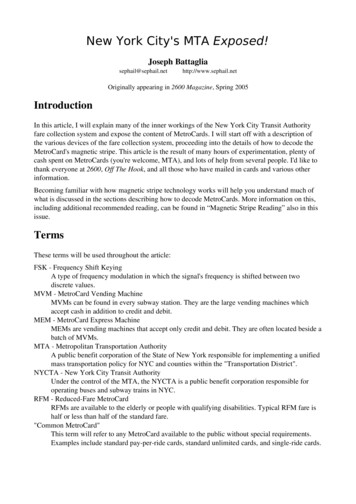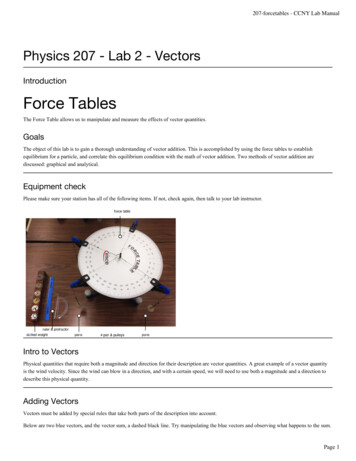
Transcription
case study The New York Times BuildingNew York, NYThe Lead Story: Lutron’s Quantum solution makes“front-page” news within The New York TimesCompany for creating a dynamic and energizingwork environment and for delivering over 70% energysavings. Details can be found at www.lutron.com/nyt.ArchitectsRenzo Piano Building WorkshopGenoa, ItalyRenzo PianoFXFOWLE ARCHITECTSNew York, NYBruce Fowle, FAIA, LEED,Senior PrincipalDan Kaplan, AIA, LEED,Senior PrincipalInterior ArchitectGenslerNew York, NYRobin Klehr Avia, FIDA,Managing PrincipalRocco Giannetti, AIA,Principal/Project ManagerEdward Wood, RA,Design PrincipalE.J. Lee,Principal/Design DirectorOliver Schaper, LEED AP,CDT, DesignerNaoko Oguro, IIDA, NCIDQ,CID, Interior DesignerTom Lanzelotti, RA, Principal/Technical DirectorPatricia Aponte, CDT,Job CaptainAylin CinarliRina Consuelo Parado, AIASusana Su-TomLutron Electronics Co., Inc.7200 Suter RoadCoopersburg, PA 18036-1299World Headquarters 1.610.282.3800Technical Support Center 1.800.523.9466Customer Service 1.888.LUTRON1All photos Nic Lehoux 06/2009 Lutron Electronics Co., Inc.Equipment ManufacturerLutron Electronics Co., Inc.Coopersburg, PAElectrical ContractorsFred Geller Electrical, Inc.New York, NYUnity Electric Co., Inc.New York, NYElectrical EngineerWSP Flack KurtzNew York, NYFred Holdorf, LC, LEED AP,Vice Presidentwww.lutron.comThe New York Times Building uses Quantum to increase comfortand productivity while saving energy (www.lutron.com/nyt).Lighting DesignerSBLD StudioNew York, NYSusan Brady, President/Design PrincipalAttila Uysal, Principal/Technical DirectorZengwei Fu, SeniorProject ManagerWen Yaun Lin, SeniorProject ManagerIP/N 367-1413Construction ManagerTurner Construction CompanyNew York, NYAll eyes in the architectural and greencommunities remain on the new 52-storyheadquarters of The New York Times Companyas its Quantum total light management systemcontinues to outdo itself in energy efficiency,saving the company significant money.An analysis of a full year’s worth of data shows,the Quantum system is achieving a 72 percentreduction in lighting energy claims GlennHughes, energy consultant and Director ofConstruction for The New York Times Companyduring the design, installation, and commissioningof The New York Times Building.“The energy savings are stunning,” says Hughes.“Lutron’s Quantum total lighting managementsystem has delivered an absolutely over-the-topperformance. When I talk with other constructionand lighting consultants, they’re astonishedat the results.”Hughes asserts that, based on an electricityrate of 0.15 per kWh, the savings from usingQuantum add up to 30,000 per year per floorfor the floors where it has been installed.This equates to approximately 1 per squarefoot per year and a prevention of over 3,300metric tons of CO2 emissions each year.He attributes the cost savings to a significantreduction in both lighting and cooling loads. Sincelights emit heat, reducing lighting power reducescooling demand. Thus, approximately 25% of thesavings stem from reduced HVAC costs.Hughes says total light management “representsthe single greatest opportunity for energy savingsin commercial buildings, whether retrofit or newconstruction projects.”The energy consultant stratified his data in a number ofdifferent ways, including season by season to take intoaccount differing conditions of natural light and heat.Last year, Hughes was widely quoted as saying“We designed our building to use 1.28 watts per squarefoot of lighting power. With Quantum , it’s using only0.38—that’s 70 percent less.”In April 2009, Hughes unveiled data showing that thebuilding’s total light management system equaled orsurpassed that figure in each of the previous four seasons:Winter 2008-2009Fall 2008Summer 2008Spring 20080.37 W/sq. ft.0.37 W/sq. ft.0.33 W/sq. ft.0.38 W/sq. ft.The seasonal data reflects yearly lightingenergy savings of 72 percent.Hughes says that the story doesn’t end by looking atenergy savings alone. Quantum dramatically improvedthe lighting environment inside The New York TimesBuilding. According to Hughes, assuming a mere 1%increase in productivity (a conservative estimate), fromthe improved lighting environment, the Quantum systempaid for itself in less than a year. He also emphasizesthat this value-add goes on year after year.
case study The New York Times BuildingNew York, NYThe Lead Story: Lutron’s Quantum solution makes“front-page” news within The New York TimesCompany for creating a dynamic and energizingwork environment and for delivering over 70% energysavings. Details can be found at www.lutron.com/nyt.ArchitectsRenzo Piano Building WorkshopGenoa, ItalyRenzo PianoFXFOWLE ARCHITECTSNew York, NYBruce Fowle, FAIA, LEED,Senior PrincipalDan Kaplan, AIA, LEED,Senior PrincipalInterior ArchitectGenslerNew York, NYRobin Klehr Avia, FIDA,Managing PrincipalRocco Giannetti, AIA,Principal/Project ManagerEdward Wood, RA,Design PrincipalE.J. Lee,Principal/Design DirectorOliver Schaper, LEED AP,CDT, DesignerNaoko Oguro, IIDA, NCIDQ,CID, Interior DesignerTom Lanzelotti, RA, Principal/Technical DirectorPatricia Aponte, CDT,Job CaptainAylin CinarliRina Consuelo Parado, AIASusana Su-TomLutron Electronics Co., Inc.7200 Suter RoadCoopersburg, PA 18036-1299World Headquarters 1.610.282.3800Technical Support Center 1.800.523.9466Customer Service 1.888.LUTRON1All photos Nic Lehoux 06/2009 Lutron Electronics Co., Inc.Equipment ManufacturerLutron Electronics Co., Inc.Coopersburg, PAElectrical ContractorsFred Geller Electrical, Inc.New York, NYUnity Electric Co., Inc.New York, NYElectrical EngineerWSP Flack KurtzNew York, NYFred Holdorf, LC, LEED AP,Vice Presidentwww.lutron.comThe New York Times Building uses Quantum to increase comfortand productivity while saving energy (www.lutron.com/nyt).Lighting DesignerSBLD StudioNew York, NYSusan Brady, President/Design PrincipalAttila Uysal, Principal/Technical DirectorZengwei Fu, SeniorProject ManagerWen Yaun Lin, SeniorProject ManagerIP/N 367-1413Construction ManagerTurner Construction CompanyNew York, NYAll eyes in the architectural and greencommunities remain on the new 52-storyheadquarters of The New York Times Companyas its Quantum total light management systemcontinues to outdo itself in energy efficiency,saving the company significant money.An analysis of a full year’s worth of data shows,the Quantum system is achieving a 72 percentreduction in lighting energy claims GlennHughes, energy consultant and Director ofConstruction for The New York Times Companyduring the design, installation, and commissioningof The New York Times Building.“The energy savings are stunning,” says Hughes.“Lutron’s Quantum total lighting managementsystem has delivered an absolutely over-the-topperformance. When I talk with other constructionand lighting consultants, they’re astonishedat the results.”Hughes asserts that, based on an electricityrate of 0.15 per kWh, the savings from usingQuantum add up to 30,000 per year per floorfor the floors where it has been installed.This equates to approximately 1 per squarefoot per year and a prevention of over 3,300metric tons of CO2 emissions each year.He attributes the cost savings to a significantreduction in both lighting and cooling loads. Sincelights emit heat, reducing lighting power reducescooling demand. Thus, approximately 25% of thesavings stem from reduced HVAC costs.Hughes says total light management “representsthe single greatest opportunity for energy savingsin commercial buildings, whether retrofit or newconstruction projects.”The energy consultant stratified his data in a number ofdifferent ways, including season by season to take intoaccount differing conditions of natural light and heat.Last year, Hughes was widely quoted as saying“We designed our building to use 1.28 watts per squarefoot of lighting power. With Quantum , it’s using only0.38—that’s 70 percent less.”In April 2009, Hughes unveiled data showing that thebuilding’s total light management system equaled orsurpassed that figure in each of the previous four seasons:Winter 2008-2009Fall 2008Summer 2008Spring 20080.37 W/sq. ft.0.37 W/sq. ft.0.33 W/sq. ft.0.38 W/sq. ft.The seasonal data reflects yearly lightingenergy savings of 72 percent.Hughes says that the story doesn’t end by looking atenergy savings alone. Quantum dramatically improvedthe lighting environment inside The New York TimesBuilding. According to Hughes, assuming a mere 1%increase in productivity (a conservative estimate), fromthe improved lighting environment, the Quantum systempaid for itself in less than a year. He also emphasizesthat this value-add goes on year after year.
First published in 1851, The New York Timeshas long enjoyed pride of place among all newsorganizations in the United States. The Times isa time-tested institution operating in the Americanmedia capital and the most fabled city of themodern world where supremacy is the norm.It’s an organization that understands that what itsays and does reverberates across many borders.It’s no surprise then that when the newspaper’sparent company, The New York Times Company,a global media enterprise, decided to build a newheadquarters in Manhattan, it eschewed the ideaof maintaining a passive role in the project.The company resolved to exercise control at everystage of the project’s design and constructionprocesses, ensuring that the new building accuratelyrepresented its corporate culture and values,and reaped real business benefits for the company.“We desired an interior environment that allowed ouremployees to be as comfortable as possible and thatwould reinforce our company’s emphasis on opencommunication, collaboration and transparency,” saidDavid Thurm, Sr. Vice President, Operations of theTimes Company. “In addition, we insisted that thebuilding be as environmentally friendly as possible.”The lighting energy savings achieved byThe New York Times Building is primarilyfrom the following strategies:10% Daylight harvestingdimming electric lights when daylightis available2% Schedulingturning lights off duringcertain times of the day30% Occupancy sensingturning off lights when spacesare vacant58% Light level tuningsetting the appropriatelight level for each spaceSource: Lutron Electronics Co., Inc.To accomplish these objectives, the Times Companyhired the world-renowned architect Renzo Piano,along with two major architectural firms, FXFOWLEof New York, and Gensler, headquartered in SanFrancisco. The Times Company also employed thelighting design services of SBLD Studio of New York.The result is a dazzling 52-story tower with 1.5 milliongross square feet jointly owned with Forest City RatnerCompanies of New York. The building is a mix ofoffice and retail. Its chief attributes are open spacesand floor-to-ceiling glass walls that provide buildingoccupants wide views of the neighboring skyscrapersand, conversely, allow outsiders to look in.“The whole building structure is designed formaximum light,” said Thurm, whose companyowns 28 floors or about 625,000 square feet—the interior space designed by Gensler. “The numberone priority was to allow natural light to make ouremployees feel more comfortable and to producean energizing work environment.”The importance of lighting controls was recognizedby the Times Company from the start. Executivesextensively researched the state-of-the-art lightingcontrol options to satisfy their twin desires for daylightharvesting and for the flexibility to reconfigurespaces easily and simply. The word extensively isnot used loosely. As Thurm himself described in anarticle published in the Harvard Business Review,virtually every decision fell under tight scrutiny todrive innovation and to avoid what he called, “wellintentioned guesses by others as to what you want.”“When you have a client interested in exploring newterritories it is very exciting,” said Edward Wood,Principal and Design Director for Gensler.“The entire project was a big research study.”Another Gensler principal echoes that sentiment:“Because they are a media organization, they arevery research-oriented, very probing, always askinga lot of questions and challenging the status quo,”said Rocco Giannetti, AIA.The research eventually gravitated to the BuildingTechnologies Department at the Lawrence BerkeleyNational Laboratory at the University of California.With guidance from the Berkeley Lab, the projectdesign team and manufacturers, the Times Companybuilt a replica of the southwest corner of its newbuilding at one of its printing facilities in Queens,New York. For six months, from winter solstice tosummer solstice, the mock-up tested an array ofdifferent lighting technologies and products from avariety of manufacturers—including a new technologyjust emerging from Lutron Electronics Co. Inc.The testing, plus Lutron’s response to a competitivebid, convinced the Times Company to select Lutron’sQuantum light management solution for its office space.Quantum employs a number of different strategies—including daylight control, occupant control, target setpoint control (light level tuning), time clock control, andemergency lighting control—to give building occupantsmaximum comfort, and to give business owners theflexibility to adapt their work environments to meetchanging business requirements. Quantum alsofeatures software to control, monitor, and reporton the lighting usage in the building.After the building had been occupied for a year, GlennHughes, now president of Glenn D. Hughes ConsultingAssociates, utilized Quantum’s 30-day energy usagereport to see for himself how much energy savings wasachieved by the Quantum solution. At the time, he saidthe following:“We designed our building to use 1.28 watts persquare foot of lighting power,” Hughes said.“With Quantum, The New York Times Companyis using only 0.38—that’s 70 percent less.”Hughes says the data he has collected and analyzednow indicates that the energy-savings performancehas risen to 72 percent.Hughes said the design goal of 1.28 watts persquare foot of lighting power was within the localcode in effect when the building was constructed.It has since tightened to 1.1 watts.Inside the New York Times Building, lightsautomatically dim when daylight is available.“Our energy performance is still way, way better,”said Hughes. He said the Lutron lighting controlsystem has established an excellent baselinefor the building which is poised to achieve evenbetter energy savings as the system parametersare tweaked. Hughes says this is the type ofenergy efficient system that supports the federalDepartment of Energy’s goal of constructingnet-zero energy buildings by 2025.“What we have achieved with our building isspectacular,” said Thurm. “But any office spaceeventually needs to move in different directionsand this lighting system gives us the flexibilityto change as we see fit.”With Quantum, the daylight sensors makethe most of natural light pouring into a space,continually and imperceptibly adjusting theelectric light levels accordingly—all the whilemaintaining a consistent overall light level asset for the people working in that space.“With all the daylight coming in, the avoidanceof glare was a crucial issue to the client,” saidAttila Uysal, Principal and Technical Director ofthe lighting design firm SBLD Studio. “Lutron’sinvolvement from the beginning was invaluable.They understood that the ‘quality’ of the lightingmattered as much as anything—and they wereable to deliver a highly sophisticated digitallighting system with a very powerful controlsoftware tool that’s easy to use and thatcarried the clients’ wishes to the nth degree.Everyone was impressed.”Uysal said every floor’s lighting scheme isdivided into zones, each with its own lightinglevels that fit the needs of the employees(depending on what type of work they perform)and based on the amount of daylight thatpenetrates that space. Roughly 18,000 digitallyaddressable EcoSystem ballasts were usedto achieve that kind of precision, accordingto Hughes. The Times Company executivesreport increased employee satisfaction.Lighting is a vital component of any constructionproject, serving as a favorite ‘form and function’instrument of architects designing a space.It reveals volume, area, ideas of scale, and itallows a building’s occupants to interact withtheir environment. As such, it affects workers’comfort levels and, in turn, their productivity.However, as any building owner or tenant canattest, this function comes at a steep price:the cost of electricity.“As a company,” Thurm said, “we intuitivelyunderstood that, if we were going to work ina building with so much outer glass, we hadto keep a rein on our energy consumption.That helps our bottom line but also is theenvironmentally responsible thing to do.”Employee comfort, increased productivity,reduced energy usage, and ease and flexibilityof use—is there a big story here? The New YorkTimes Company already has decided.For more information,visit www.lutron.com/nyt.
First published in 1851, The New York Timeshas long enjoyed pride of place among all newsorganizations in the United States. The Times isa time-tested institution operating in the Americanmedia capital and the most fabled city of themodern world where supremacy is the norm.It’s an organization that understands that what itsays and does reverberates across many borders.It’s no surprise then that when the newspaper’sparent company, The New York Times Company,a global media enterprise, decided to build a newheadquarters in Manhattan, it eschewed the ideaof maintaining a passive role in the project.The company resolved to exercise control at everystage of the project’s design and constructionprocesses, ensuring that the new building accuratelyrepresented its corporate culture and values,and reaped real business benefits for the company.“We desired an interior environment that allowed ouremployees to be as comfortable as possible and thatwould reinforce our company’s emphasis on opencommunication, collaboration and transparency,” saidDavid Thurm, Sr. Vice President, Operations of theTimes Company. “In addition, we insisted that thebuilding be as environmentally friendly as possible.”The lighting energy savings achieved byThe New York Times Building is primarilyfrom the following strategies:10% Daylight harvestingdimming electric lights when daylightis available2% Schedulingturning lights off duringcertain times of the day30% Occupancy sensingturning off lights when spacesare vacant58% Light level tuningsetting the appropriatelight level for each spaceSource: Lutron Electronics Co., Inc.To accomplish these objectives, the Times Companyhired the world-renowned architect Renzo Piano,along with two major architectural firms, FXFOWLEof New York, and Gensler, headquartered in SanFrancisco. The Times Company also employed thelighting design services of SBLD Studio of New York.The result is a dazzling 52-story tower with 1.5 milliongross square feet jointly owned with Forest City RatnerCompanies of New York. The building is a mix ofoffice and retail. Its chief attributes are open spacesand floor-to-ceiling glass walls that provide buildingoccupants wide views of the neighboring skyscrapersand, conversely, allow outsiders to look in.“The whole building structure is designed formaximum light,” said Thurm, whose companyowns 28 floors or about 625,000 square feet—the interior space designed by Gensler. “The numberone priority was to allow natural light to make ouremployees feel more comfortable and to producean energizing work environment.”The importance of lighting controls was recognizedby the Times Company from the start. Executivesextensively researched the state-of-the-art lightingcontrol options to satisfy their twin desires for daylightharvesting and for the flexibility to reconfigurespaces easily and simply. The word extensively isnot used loosely. As Thurm himself described in anarticle published in the Harvard Business Review,virtually every decisio
Design Principal E.J. Lee, Principal/Design Director Oliver Schaper, LEED AP, CDT, Designer Naoko Oguro, IIDA, NCIDQ, CID, Interior Designer Tom Lanzelotti, RA, Principal/ Technical Director Patricia Aponte, CDT, Job Captain Aylin Cinarli
